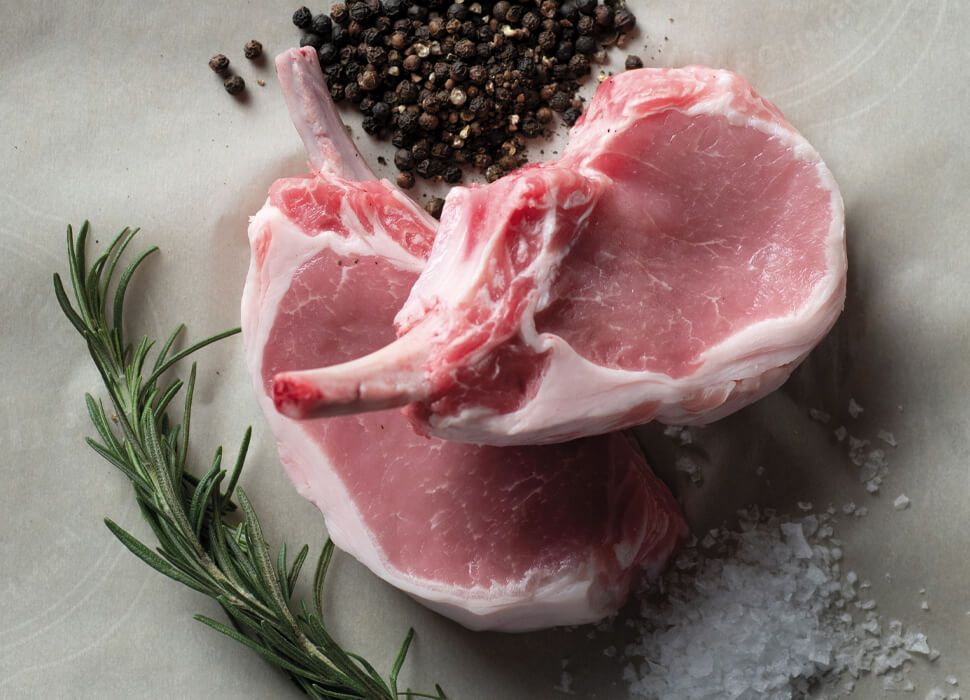Easter means ham season!
Although we usually think of hams as salty sliced pork that is cured or smoked, the cooking method isn’t what makes it a ham. Just like a pork tenderloin, “ham” refers to the cut of meat, rather than a style of preparation. A ham comes from the back thigh, or rump, of a pig.
This tasty treat is a staple protein at Easter dinner. Here’s what you need to know to bring a ham feast to your family table this spring!
Choosing a Bone-in vs. Boneless Ham
There are major benefits to both bone-in and boneless hams, and both will be wonderful on the Easter dinner table.
Bone-in Ham
A whole bone-in ham includes both the shank and leg bones, which are said to impart extra flavor when cooking. That’s why these hams can be particularly tasty, and a bit more expensive per pound. Most hams in American grocery stores are pre-cooked, but it is possible to find uncooked bone-in hams as well.
The bones running through the middle of the meat make these styles a bit trickier to carve at the dinner table. But if you plan to make a soup or stock with any leftovers, you can reuse that bone for a flavorful broth.
Boneless Ham
Boneless hams are delicious and easy to prepare. These hams are pre-cooked, and they heat up more quickly than pre-cooked bone-in hams.
Plus they can be easily sliced for quick service, so you can spend more time eating and less time carving.

Semi-Boneless Ham
There’s one more option — the semi-boneless ham. In a semi-boneless ham, the shank bone has been removed, but the leg bone remains. Some people think this offers the best of both worlds, since it still has a flavorful bone, but is easier to carve than bone-in.
How to Calculate the Right Size Ham for Easter
How big of a ham should you buy for your holiday meal? The answer comes down to your party size, leftover needs, and what else will be on the Easter table.
Basic Ham Weight Calculation
To calculate the right size ham for your occasion start by planning for ½ pound of boneless ham per person, or ¾ pound of bone-in ham per person. The extra weight for bone-in doesn’t assume your guests will eat more. It just accounts for the extra, inedible weight of the bone.
Here’s an easy calculator to help with the math.
Accounting for Kids and Teens
But what if half your guests are children — or ravenous teenagers?
The above calculation assumes that your guests are the “average” adults. If you’re expecting small children with small appetites, you may want to cut their portions down by ¼ pound. And if you have a house full of active teens or hungry adults you may want to increase their allotment by ¼ pound.
A final calculation could look like this for a boneless ham:
- 6 adults x ½ lb. of ham each = 3 pounds of ham
- 4 small kids x ¼ lb. of ham each = 1 pound of ham
- 3 big-appetite teens or adults x ¾ lb. of ham each = 2 ¼ pounds of ham
- Total ham weight = 6 ¼ pounds
How to Size a Ham With Extra Main Course Proteins on the Menu
If you’re planning to have additional main course protein options like turkey or roast beef, you won’t need as much ham to satisfy your guests. Generally, ½ pound to ¾ of a pound of total meat per person is a good baseline.
So if you are serving a second protein, split your total amount per person between the two. For example, you may want to account for ¼ pound of ham and ¼ pound of roast beef per person, to reach a total weight of ½ pound of protein per guest.
What About Leftovers?
Leftover ham is one of the delights of Easter!
Fortunately, once you know how much ham you need to feed your crew, you can make an educated decision about leftovers. If you plan to make a specific recipe with leftover ham, add the amount the recipe calls for to your calculation. For this tasty Ham Salad, for example, you would add 12 ounces of ham to your final weight.

If you simply want some extra for sandwiches, omelets, or snacks the week after Easter, add 1 to 2 pounds to your total weight. Cooked ham stays good in the refrigerator for three to five days. To preserve it for longer, place it in a freezer bag or airtight container and freeze. Frozen ham will stay edible for one to two months. Defrost in the refrigerator or microwave, never in hot water!

How to Cook an Easter Ham
Your cooking method will depend on the type of ham you choose.
Most hams are cured or smoked, so they simply need to be heated up to be ready to eat. Other hams, like those from Coleman Natural, may be labeled “uncured” because they use naturally occurring nitrites like those in celery powder or sea salt, instead of synthetic nitrites or nitrates. These hams are still fully cooked and have that same rich saltiness as cured hams.
Fresh hams, on the other hand, are raw, and must be cooked thoroughly before they’re ready to eat.
How to Prepare a Fully-Cooked Ham
Your pre-cooked ham just needs to get nice and hot. Watch out for overheating, which can make your ham dry.
Instructions:
- Preheat the oven to 325°F.
- Place the ham on a rack on a shallow roasting pan. You may want to add some liquid to the roasting pan, like broth, wine, or even water.
- Tent foil over the ham while baking. This will help it stay moist.
- Heat for 15 to 18 minutes for each pound of meat.
- The ham will be ready to remove when the internal temperature reaches 140°F.
- Leave the foil on and let the ham rest for about 20 minutes once it’s out of the oven to avoid losing all the juices when you cut into it.
Since ham is salty, a sweet glaze can help to balance the flavor. Some hams come with a glaze packet*, or you can make your own. When the ham is almost to its proper internal temperature, remove it from the oven and brush the glaze evenly across the surface of the ham. Put it back in the oven at 450°F, uncovered, until the ham reaches an internal temperature of 140°F. Watch carefully! Sugary glazes can burn easily.

You could also skip the glaze entirely, and instead make some dipping sauces to spice up the meal. You could make a mustard sauce, sweet raisin sauce, or a pineapple sauce to add some depth to your salty ham.
*Make sure to read the instructions on your ham’s glaze packet, as they may vary.
How to Cook a Fresh Ham
A fresh ham (also called a green ham) is not pre-cooked, so it will need to be cooked to an internal temperature of at least 160°F before it’s ready to eat.
Instructions:
- Bring the ham to room temperature.
- Preheat the oven to 325°F.
- Place the ham on a rack in a shallow roasting pan.
- Cook for about 20 minutes per pound, uncovered, until the internal temperature reaches 160°F.
- Let it rest for about 20 minutes once it’s out of the oven to let the juices reabsorb into the meat.
Just like a pre-cooked ham, you can add a glaze during the last 30 minutes or so of cooking, and let it finish uncovered. Or, you can apply a spice or herb rub to the ham before cooking for added flavor. Thyme, garlic, oregano, and sage are all delicious additions!

Happy Easter!
Your Easter ham is a holiday centerpiece that the family will look forward to all spring. Hams from Coleman Natural Foods are fully cooked and sourced from crate-free, American family farms that never use antibiotics or added hormones. With no artificial ingredients or preservatives, you can feel good about putting Coleman Uncured Ham Steaks on the dinner table.
Enjoy your holiday ham, and happy Easter from the Coleman family to your family.


